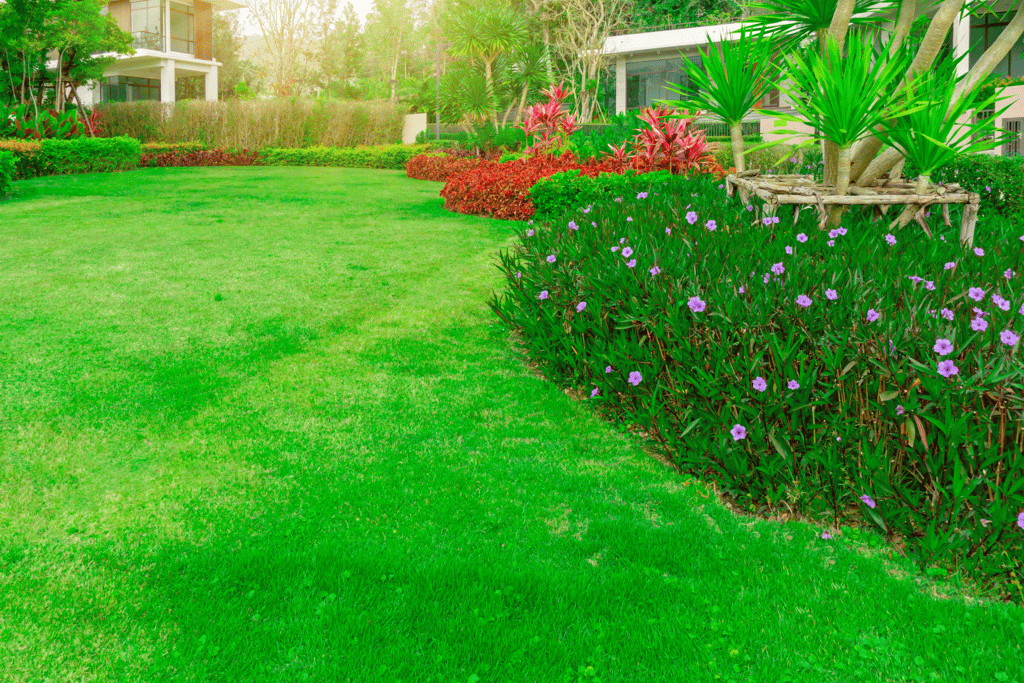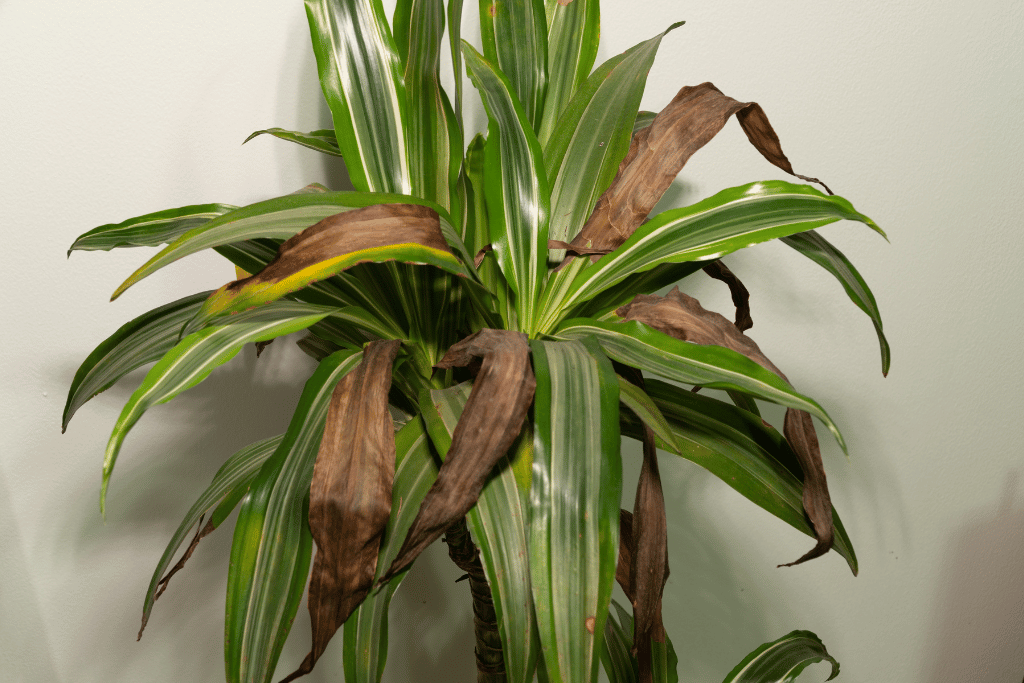
Bermuda grass scalping is a necessary practice to keep your turf looking tip-top. Scalping is the method of cutting back the grass low enough to prevent thatching.
What is Thatching? Thatching results from the stolons (above-ground stems) and rhizomes (below-ground stems) of the grass that overlap. Over time this overlapping builds up and can attract pests and diseases and affect the water absorption of the turf.
By scalping Bermuda grass in the early spring of the second year, you are not only giving space for new growth to emerge but helping the turf to stay super healthy!
This step-by-step guide dives into the details of why, when, and how to scalp Bermuda grass. So, whether you are new to Scalping Bermuda grass or do it every year, I am sure you will find some tips and tricks throughout this article.

What is Scalping Bermuda Grass?
Lawn scalping is where you deliberately cut back the dried brown grass to a low level to increase sun exposure. By decreasing the amount of dead leaf tissue, you open the lawn up to receive as much air and sunlight as possible.
Scalping the warm-loving Bermuda grass in the early spring allows the soil to warm up and give it a head start in time for the growing season.
Bermuda grass stems grow in directions above and along the ground. The stems which are above the ground are known as stolons, whereas the stems that grow below the ground are referred to as rhizomes.
When these stems grow each season, they create a dense carpet that turf experts call thatching. If the turf is left to thatch for an extended period of time, this thatching makes an inviting place for pests and diseases to harbor.
Other terms you may hear in relation to scalping are low mowing, dethatching, and low cutting; they all mean the same, so no stress if you hear it called something else!
Why Should I Scalp Bermuda Grass?
Bermuda grass is a warm-loving grass that can take a good haircut! Just like our hair, when the Bermuda grass is cut, it stimulates new healthy growth.
Scalping Bermuda grass removes the spent straw-like grass and dormant stems, making way for fresh, lush green growth. Scalping your lawn is not a difficult task. When done at the right time, it will reduce thatching, potentially saving your lawn from developing diseases and becoming overrun with weeds during summer.
The Best Time to Scalp Bermuda Grass
When it comes to scalping Bermuda grass, the best time of year will depend on your location. When there is no frost risk, the early stages of spring (late February to early March) are the best time to scalp Bermuda grass.
Use a temperature gauge to check the soil temperature. Ideally, the temperature should be 60F (16C) when scalping Bermuda grass. If your Bermuda grass has thrived throughout the spring and early summer, you may need to give it another scalp before fall.
Avoid scalping Bermuda grass in the fall, as the Bermuda grass will need to develop a protective layer of grass to insulate the roots during the cold winter months. If you do decide to scalp late summer, only do so if the lawn is healthy and there are no signs of stress from drought.
On the contrary, avoid scalping your lawn after heavy rain or irrigation; the clippings will be challenging to move and will take a lot of time and energy!

How Do I Scalp Bermuda Grass?
Now that you understand the benefits of scalping Bermuda grass and when to do it, let’s take a look at how it is done.
Step 1. Arrange your Scalping Tool
Preparation is the key before scalping your Bermuda grass. Ensure the blade of the mower is clean and sharp. A blunt blade will wound the turf, cause it to bruise and turn brown, and also wreak havoc on your mower engine.
You can sharpen your blades yourself by using a file, bench grinder, rotary tool or angle grinder. I use the sharpening attachment on my rotary tool because it is lightweight and easy to handle.
Begin with newly sharpened mower blades and set the cutting deck to 0.5 (1.27cm) or 1 inch high (2.5cm). Fix the bag to the mower to collect the clippings- there will be a lot by the end, and gathering them by hand is a timely job!
Step 2. Start Scalping
With all the settings in place, it’s time to fire up your mower. If your garden is on a slope or has areas with rough terrain, you may need to use a smaller mower for those areas. Because the lawn mower blades are set to a low level, it can catch rocks or lumps on the ground much easier, damaging your mower and lawn- take it easy over the bumpy areas!
Mow the lawn by moving in the direction that flows to the shape of the garden; for example, mow vertically on the longest length and horizontally on the shortest. By changing the direction of owing, you allow the blades of Bermuda grass to grow upright rather than at an angle.
Step 3. Collect the Clippings
If you have used a bag on your mower, then great-this step will take you only a short time! Alternatively, you will need to collect all the clippings with a garden rake by hand. There are likely to be ALOT of clippings, and unlike regular mowing – you do need to remove them all.
By leaving the clippings in place after scalping, you are defeating the point of scalping- to increase sun exposure. Wet clippings that are left on the surface of the freshly scalped lawn can cause rot to the exposed roots. Collect the clippings and put them in your composter or a pile at the back of your garden.
Avoid wasting grass clippings; these are super high in nitrogen and can add nutrients to your garden beds.
Step 4. Aerate after Scalping
Aerating the lawn after scalping is unnecessary but will benefit your grass’s health in the long run. Aeration is a method where you perforate the soil with small holes so the soil can absorb water, air, and nutrients efficiently.
To aerate the soil, you will need an aerator, and you can rent or buy one from your local lawn care professional or home improvement store. Before aerating, ensure you water the lawn to soften the soil. This will make it easier for the plugs to penetrate the soil. After aerating, use a high-nitrogen fertilizer to give the lawn an extra boost.
Find out the Best Lawn Mower for Bermuda Grass.
After Care for Scalped Bermuda Grass
After the main job is done, you may wonder what to do after scalping Bermuda grass. Water your lawn after scalping to encourage new growth. Give the lawn a deep water following scalping and avoid overwatering- this can lead to disease and other problems.
Following the scalping of Bermuda grass, it’s best to fertilize and use a high-nitrogen fertilizer. Lawn fertilizers are available from your local garden center or online. Always follow the instructions on the pack to ensure proper application rates and timing.
Once fertilized, wait for new growth to appear. It can take up to several weeks, but patience is the key, so avoid the temptation of re-mowing!
The Final Cut
Scalping Bermuda grass is highly beneficial to the health of your lawn as it removes old growth and keeps your lawn looking lush and vibrant. Despite how it sounds, scalping is an easy method and can be done by beginner gardeners, provided they have the right tools.
The main factors to consider when scalping is the time of year to scalp (spring), how low to cut (0.5-1inch), and the aftercare or scalping.
By following these methods, you can enjoy a beautiful, healthy lawn this summer and be the envy of your neighborhood!
FAQ About Scalping Bermuda Grass
How short should I scalp Bermuda grass?
To scalp Bermuda grass, you must set your mower blade to 0.5 inches (1cm) high. Be mindful of varying levels in your garden as this is a low cut, and any changes in the terrain may cause damage.
Will Bermuda grass grow back after scalping?
Bermuda grass grows back after scalping, and you can expect to see new healthy growth within several weeks. This time frame may vary depending on weather conditions.
How long does it take for scalped Bermuda grass to recover?
Bermuda grass is a hardy perennial grass and will recover 3- 4 weeks after scalping when in the right conditions. To help Bermuda grass recover water after scalping and apply a high-nitrogen fertilizer.
Do turf grass specialists recommend scalping Bermuda grass yards in early spring?
Turf specialists recommend scalping Bermuda grass from mid-March to late April when there is no risk of frost. A sure sign is when you start to see new green growth emerge from the brown dormant stems.



